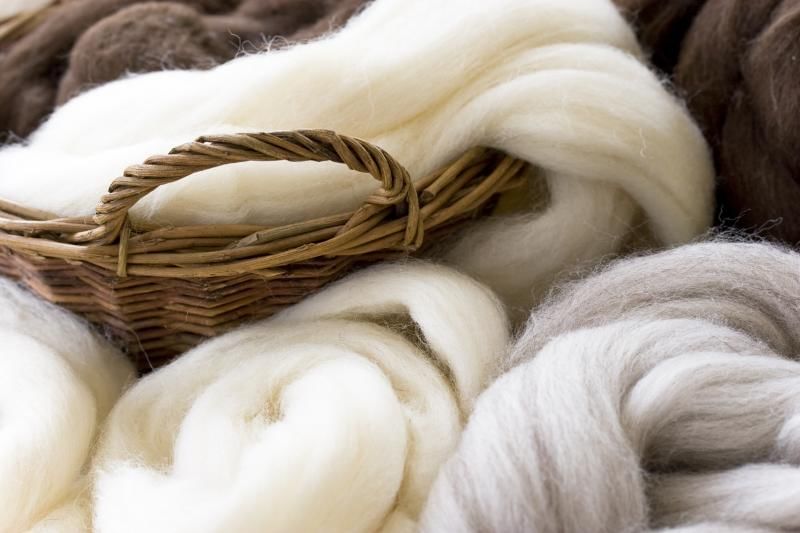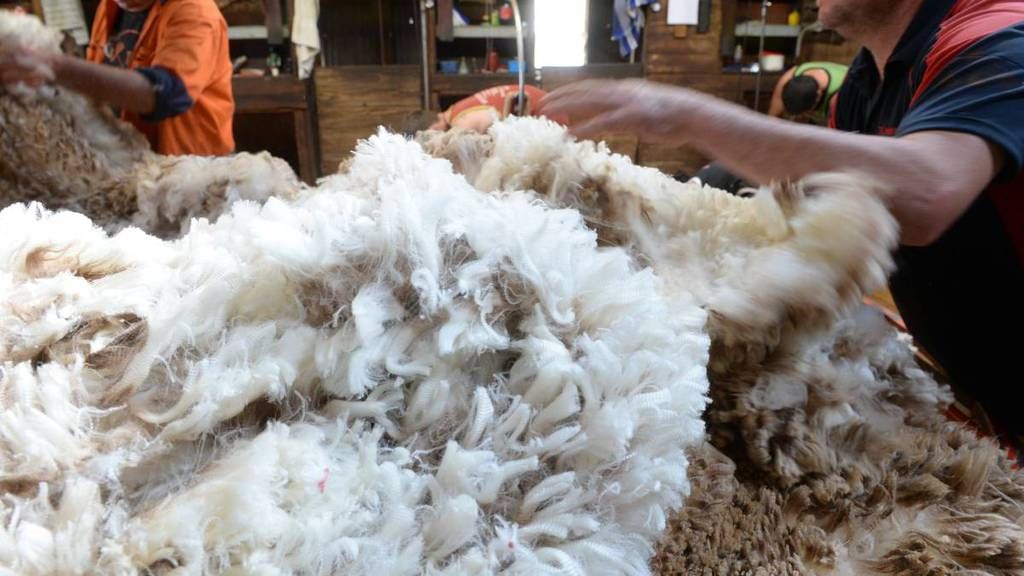Brief Overview: Fibre to Fabric | Advance Learner Course: Science Class 6 PDF Download
Animal Fibre - Wool
Wool comes mostly from sheep. It was the first fibre to be spun into yarn, and it provides more warmth than other animal fibres.
 WoolWool comes mostly from sheep. It was the first fibre to be spun into yarn, and itprovides more warmth than other animal fibres. Apart from sheep, wool also comes from the angora goat, yak, llama, alpaca, and even camels. All these animals have a thick coat of hair or fleece, which keeps them warm. Wool is obtained from this fleece. Sheep wool is more commonly available in India. In Tibet and Ladakh, yak wool is more common, whereas in Jammu and Kashmir, it is the angora wool. The famous Pashmina shawls come from the soft under-fur of the Kashmiri goat. In South America, the llama and the alpaca are two animals that yield wool. Actually, there are many different breeds of sheep that are reared in different parts of our country to obtain wool. Some breeds of sheep are selectively reared. This means that their parents are chosen for their special characteristics to give birth to them. For example, some sheep are selected because they have soft under-hair. This process is called 'selective breeding'. The Nali and Lohi breeds are found in Rajasthan and Punjab, the Rampur bushair in Uttar Pradesh and Himachal Pradesh, and the Bakharwal in Jammu and Kashmir. Gujarat breeds the Marwari and Patanwadi sheep. Each breed yields wool used for different purposes.
WoolWool comes mostly from sheep. It was the first fibre to be spun into yarn, and itprovides more warmth than other animal fibres. Apart from sheep, wool also comes from the angora goat, yak, llama, alpaca, and even camels. All these animals have a thick coat of hair or fleece, which keeps them warm. Wool is obtained from this fleece. Sheep wool is more commonly available in India. In Tibet and Ladakh, yak wool is more common, whereas in Jammu and Kashmir, it is the angora wool. The famous Pashmina shawls come from the soft under-fur of the Kashmiri goat. In South America, the llama and the alpaca are two animals that yield wool. Actually, there are many different breeds of sheep that are reared in different parts of our country to obtain wool. Some breeds of sheep are selectively reared. This means that their parents are chosen for their special characteristics to give birth to them. For example, some sheep are selected because they have soft under-hair. This process is called 'selective breeding'. The Nali and Lohi breeds are found in Rajasthan and Punjab, the Rampur bushair in Uttar Pradesh and Himachal Pradesh, and the Bakharwal in Jammu and Kashmir. Gujarat breeds the Marwari and Patanwadi sheep. Each breed yields wool used for different purposes.
- carpet wool.is used to make Nali breed wool
- hosiery. is used for Patanwadi wool
- clothes.is of very good quality, and is used for making Lohi wool
- shawls. wool is used for Bakharwal
Sheep are herbivores, and prefer grass and leaves. However, shepherds also feed them mixtures of pulses, corn, jowar, oil cakes and minerals. In winter, they are fed leaves, grain and dry fodder.
- Shearing is the first step in processing fibre into wool. It is the removal of the fleece of the sheep along with a thin layer of the skin.
- The next step is to clean the sheared skin and hair. This is done in big tanks to remove the grease, dust and dirt. This is called scouring.
- The fleece is sorted according to its texture and type.
- Since the fibres are mostly black, brown or white in colour, they can now be dyed in various colours.
- Once the dyeing process is complete, the fibres are straightened, combed and rolled into yarn.
- The longer fibres are made into wool for sweaters, while the shorter fibres are spun and woven into woollen cloth.
 Wool extracted from sheep
Wool extracted from sheep
In our country, many people earn their livelihood from the wool industry. However, the sorter's job can be dangerous. They can get infected by a bacterium called anthrax, which causes a fatal blood disease called sorter's disease. When workers face such risk due to their occupation, it is called an occupational hazard. Sheep rearing is a lot of hard work.
Animal Fibre - Silk
Silk is the queen of textiles. It is an animal fibre produced by the silkworm to build its cocoon.
Silk is the queen of textiles. It is an animal fibre produced by the silkworm to build its cocoon. Silk was discovered in China, when empress Si-lung-Chi was worried about the damaged mulberry leaves in her garden. Emperor Huang-ti found that white worms were eating up the mulberry leaves and spinning shiny cocoons.
Silkworms are not worms actually, but the larvae or caterpillars that have hatched from the eggs of the silk moth.
Different types of silk moths yield different types of silk yarn, such as:
- silk Tassar
- silk Moonga
- Kosa silk
Silk is the strongest of all natural fibres. A soft silk yarn is as strong as a comparable thread of steel. Sericulture, or silk farming, is the rearing of silkworms for the production of raw silk.
- The female silk moth lays hundreds of eggs. These are stored on strips of cloth or paper.
- The eggs are then sold to silkworm farmers, who rear them under specific hygienic conditions.
- When the mulberry tree bears a fresh crop of leaves, the eggs are warmed suitably so that the larvae hatch from them.
- The larvae, caterpillars or silkworms are then stored in clean bamboo trays and are fed freshly chopped mulberry leaves. They eat day and night, and grow to enormous sizes.
- The bamboo trays are provided with small racks or twigs to which the cocoons can be attached.
- This happens usually 25 to 30 days later, when the caterpillars stop feeding and move to the twigs to spin cocoons. The silk moth develops inside these cocoons.
- As caterpillars eat and grow bigger, they also shed their skin. Underneath the old one is a new skin. Caterpillars may shed skin four or five times.
Extracting silk from the cocoon:
- The first step is to separate the silk fibre from the cocoon. For this, they need to be exposed to warmth.
- Piles of cocoons are kept under the sun, boiled or exposed to steam. The warmth causes the silk fibre to separate from the rest of the cocoon.
- The next step is called reeling the silk, which is the process of delicately unwinding the fibre from the cocoon. These silk filaments are soft, and 300 to 900 metres long.
- Reeling is also done in special machines.
- The silk thread is then bleached and dyed into many shades.
- The silk fibre is now spun into silk thread, which is then woven into silk cloth by weavers.
In our country, women are involved in a big way in the sericulture industry. They contribute to processes of rearing of silkworms, reeling of silk from cocoons, and processing of raw silk into fabric. This enterprise contributes to the nation's economy and also helps rank India among the leading silk producing countries. Of course, China leads the world in silk production.
|
26 videos|32 docs|9 tests
|
FAQs on Brief Overview: Fibre to Fabric - Advance Learner Course: Science Class 6
| 1. What is the process of making fabric from fibre? |  |
| 2. What are the different types of fibres used in making fabric? |  |
| 3. How is cotton fibre different from wool fibre? |  |
| 4. What is the importance of fibre to fabric in the textile industry? |  |
| 5. How does synthetic fibre compare to natural fibre in terms of sustainability? |  |

















